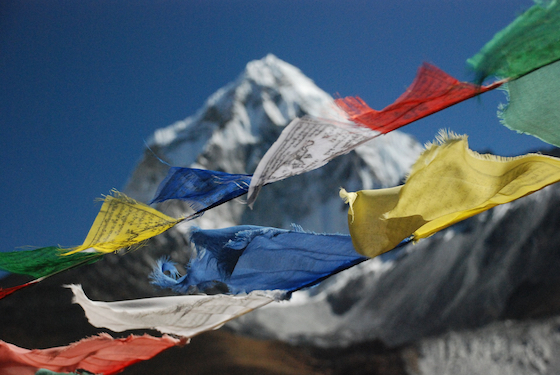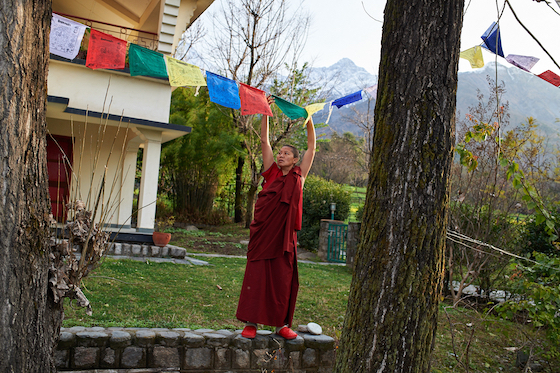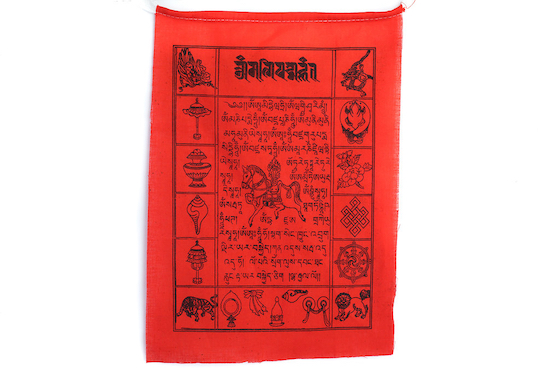About Tibetan Buddhist Prayer Flags
Tibetan prayer flags are used to promote peace, wisdom, and compassion. The bright cloth flags are printed with auspicious symbols, invocations, prayers, and mantras. Tibetans believe that the prayers will be spread by the wind, bringing goodwill and auspiciousness to all beings.
 The hanging of prayer flags is a tradition dating back thousands of years to ancient Buddhist India and to the Bon tradition of pre-Buddhist Tibet. Tibetans hang prayer flags at mountain passes and at temples, stupas, and other sacred structures so their prayers can be released.
The hanging of prayer flags is a tradition dating back thousands of years to ancient Buddhist India and to the Bon tradition of pre-Buddhist Tibet. Tibetans hang prayer flags at mountain passes and at temples, stupas, and other sacred structures so their prayers can be released.
Sadly, Chinese authorities have recently ordered the destruction of prayer flags in many areas of Tibet in what has been called “one of China’s most direct assaults to date on visible symbols of Tibetan culture and religious belief”.
Meaning of the Tibetan Prayer Flag Colors
Tibetan prayer flags are rich in symbolic meaning. The flags come in sets of five and are hung left to right in this specific order: blue, white, red, green, and yellow. Each of the colors represents an element. Blue symbolizes the sky and space, white symbolizes the air and wind, red symbolizes fire, green symbolizes water, and yellow symbolizes earth.

A Tibetan Buddhist nun hangs windhorse prayer flags at Dolma Ling Nunnery and Institute. Photo courtesy of Olivier Adam
You don’t have to be a Buddhist to hang prayer flags, but they should be handled with respect. As you hang them, you should have good motivation, keeping in mind the flags’ ultimate purpose to spread positivity far and wide.
The square-shaped, horizontally strung prayer flags are the most common, but there are also vertical prayer flags mounted on poles.
Windhorse Prayer Flags
The wind horse or lungta is the most prevalent symbol used on Tibetan prayer flags. These are the most popular prayer flags sold in our online store. All the prayer flags sold by the Tibetan Nuns Project are handmade and blessed by the Tibetan Buddhist nuns at Dolma Ling Nunnery and Institute in India. Proceeds from the sales help fund education, food, shelter, clothing and health care for over 800 nuns at seven nunneries in India.
In the center of the windhorse prayer flag is the image of a powerful horse called a lungta or རླུང་རྟ in Tibetan. On its back, the horse bears three flaming jewels which are the cornerstones of Tibetan philosophical tradition. These jewels represent the Buddha, the dharma (the Buddhist teachings), and the sangha (the Buddhist community). The horse (ta orརྟ in Tibetan) is a symbol of speed and the transformation of bad fortune to good fortune.

Surrounding the windhorse or lungta are mantras or prayers written in Tibetan. Clockwise starting from the top left corner of the prayer flags are images of four powerful animals, also known as the Four Dignities: the garuda, the dragon, the snow lion, and the tiger.
Together the Four Dignities represent the attitudes and sacred qualities that Bodhisattvas develop on the path to enlightenment – qualities such as fearlessness (garuda), gentle power (dragon), clear awareness (snow lion), and confidence (tiger).
On both sides of the prayer flag are the eight auspicious symbols of Buddhism which represent the offerings made to the Buddha when he attained enlightenment:
- The Precious Parasol
- The Vase of Great Treasures
- The White Conch Shell
- The Victory Banner
- The Two Golden Fish
- The Lotus Flower
- The Eternal Knot
- The Eight Spoked Wheel
Windhorse prayer flags made by the nuns are available in three sizes. You can buy Windhorse Prayer flags here.
Hanging prayer flags at your home or business brings a feeling of harmony and calls to mind the teachings of the Buddha. Proper motivation is important when raising prayer flags. You should hang them with the wish that all beings everywhere will find happiness and be free from suffering.

Tashi Delek to all Nuns at the TNP. Wishing all free of suffering and illness.
Pingback: Experience the Vibrant Power of Prayer Flags Today
Pingback: Explore the Rich Symbolism of Traditional Prayer Flags